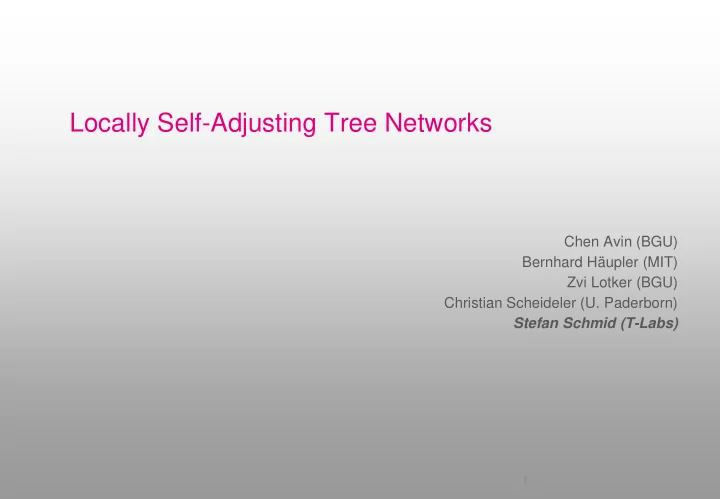

Locally Self-Adjusting Tree Networks Chen Avin (BGU) Bernhard Häupler (MIT) Zvi Lotker (BGU) Christian Scheideler (U. Paderborn) Stefan Schmid (T-Labs) 1
From “Optimal” Networks to Self -Adjusting Networks Networks become more and more dynamic (e.g., flexible SDN control) Vision: go beyond classic “optimal” static networks Example (of this paper): Peer-to-peer Pancake Chord, Pastry, SHELL Koorde, ... Log/loglog degree and Hypercubic Constant degree log/loglog routing Log diameter Log routing Log degree Log routing 2 Stefan Schmid (T-Labs)
From “Optimal” Networks to Self -Adjusting Networks Networks become more and more dynamic (e.g., flexible SDN control) Vision: go beyond classic “optimal” static networks Wh What at if if ne networks orks coul ould d sel elf-adjust adjust de depe pendin nding g Example: Peer-to-peer Pancake Chord, Pastry, SHELL on comm on ommunic unication ation pat Koorde, ... attern? ern? Hypercubic Log/loglog degree and Constant degree Log diameter log/loglog routing Log routing Log degree Log routing 3 Stefan Schmid (T-Labs)
An Old Concept: Move-to- front, Splay Trees, … Classic data structures: lists, trees Linked list: move frequently accessed elements to front! Trees: move frequently accessed elements closer to root 4 Stefan Schmid (T-Labs)
An Old Concept: Move-to- front, Splay Trees, … Classic data structures: lists, trees Linked list: move frequently accessed elements to front! Trees: move frequently accessed elements closer to root 5 Stefan Schmid (T-Labs)
An Old Concept: Move-to- front, Splay Trees, … Classic data structures: lists, trees Linked list: move frequently accessed elements to front! Trees: move frequently accessed elements closer to root 6 Stefan Schmid (T-Labs)
An Old Concept: Move-to- front, Splay Trees, … Classic data structures: lists, trees Linked list: move frequently accessed elements to front! Trees: move frequently accessed elements closer to root 7 Stefan Schmid (T-Labs)
An Old Concept: Move-to- front, Splay Trees, … Classic data structures: lists, trees Linked list: move frequently accessed elements to front! Trees: move frequently accessed elements closer to root 8 Stefan Schmid (T-Labs)
An Old Concept: Move-to- front, Splay Trees, … Classic data structures: lists, trees Linked list: move frequently accessed elements to front! Trees: move frequently accessed elements closer to root Splay Trees! Splay Trees! 9 Stefan Schmid (T-Labs)
The Vision: Splay Networks (“Distributed Splay Trees”) Most simple self-adjusting tree network: Binary Search Tree (BST) 10 Stefan Schmid (T-Labs)
The Vision: Splay Networks (“Distributed Splay Trees”) Most simple self-adjusting tree network: Binary Search Tree (BST) 11 Stefan Schmid (T-Labs)
The Vision: Splay Networks (“Distributed Splay Trees”) Most simple self-adjusting tree network: Binary Search Tree (BST) Communication between peer pairs! (Not only lookups from root…) 12 Stefan Schmid (T-Labs)
The Vision: Splay Networks (“Distributed Splay Trees”) Most simple self-adjusting tree network: Binary Search Tree (BST) Why BST?! Most simple generalization of - classic data structure Allows for local routing! - Allows for algebraic gossip - 13 Stefan Schmid (T-Labs)
Model: Self-Adjusting SplayNets Input: communication pattern: (static or dynamic) graph “Guest Graph” Output: sequence of network adjustments Cost metric: expected path length # (local) network updates “Host Graph” 14 Stefan Schmid (T-Labs)
Our Contribution SplayNets “ Online algorithm” for self-adjusting distributed trees Optimal offline algorithm (polynomial time, for large class of graphs!) Performance evaluation: General bounds on amortized costs Lower bounds (empirical entropy) Analysis of convergence times for important static comm. patterns Optimality of online algorithm for special patterns (e.g., matchings) Simulation study (Facebook data) 15 Stefan Schmid (T-Labs)
The Optimal Offline Solution Dynamic program Binary search: decouple left from right! Polynomial time (unlike MLA!) So: solved M”BST”A See also: Related problem of phylogenetic trees OPT OPT OPT 16 Stefan Schmid (T-Labs)
The Online SplayNets Algorithm From Splay tree to SplayNet: 17 Stefan Schmid (T-Labs)
The Online SplayNets Algorithm From Splay tree to SplayNet: 18 Stefan Schmid (T-Labs)
The Online SplayNets Algorithm From Splay tree to SplayNet: Least Common Ancestor Local rotations! 19 Stefan Schmid (T-Labs)
Analysis: Basic Lower and Upper Bounds Lower Bound Upper Bound A-Cost < H(X) + H(Y) A-Cost > H(X|Y) + H(Y|X) where H( | ) are conditional where H(X) and H(Y) are entropies. empirical entropies of sources resp. destinations Assuming that each node is Adaption of Tarjan&Sleator the root for “its tree” Therefore, our algorithm is optimal, e.g., if communication pattern describes a product distribution! 20 Stefan Schmid (T-Labs)
Properties: Convergence Cluster scenario: Nodes communicate within local clusters only! IDs Over time, nodes will form clusters in BST! No paths “outside”. 21 Stefan Schmid (T-Labs)
Properties: Optimal Solutions Laminated scenario: Will converge to optimum: Amortized costs 1. IDs Non- crossing matching (= “no polygamy”) scenario: Will converge to optimum: Amortized costs 1. IDs 22 Stefan Schmid (T-Labs)
Properties: Optimal Solutions Multicast scenario (BST): Example Invariant over “stable” subtrees (from right): 23 Stefan Schmid (T-Labs)
Improved Lower Bounds (and More Optimality) Via interval cuts or conductance entropy: IDs Grid: Cut of interval: entropy yields amortized costs! 24 Stefan Schmid (T-Labs)
Simulation Results Facebook component with 63k nodes and 800k edges SplayNet exploit random walk locality, to less extent also matching 25 Stefan Schmid (T-Labs)
Conclusion Vision: self-adjusting networks Interesting generalization of Splay trees SplayNets Formal analysis reveals nice properties Amortized costs good: but tight? Competitive ratio remains open Future work? Yes 26 Stefan Schmid (T-Labs)
Thank you! Questions? “Guest Graph” “Host Graph” 27 Stefan Schmid (T-Labs)
Recommend
More recommend